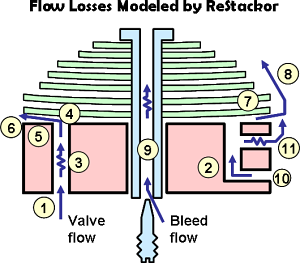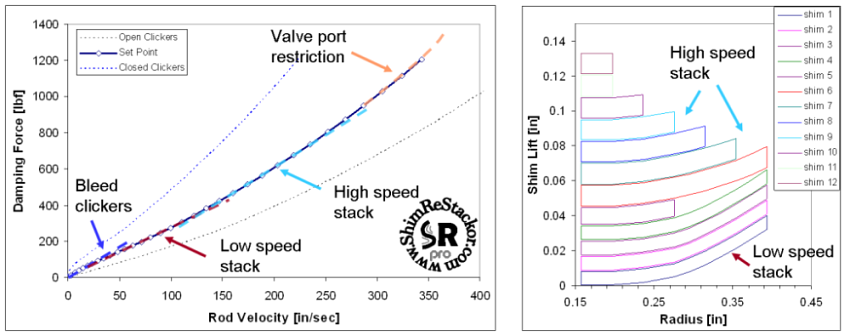


Fundamental Physics of ReStackor Shock Absorber Analysis
In
the past, experience and intuition were the only guides in tuning suspensions.
Successful seat-of-the-pants tuning
required a huge experience base to guess the series of shim stack changes needed to correct
a specific suspension problem.
Changing the low-speed stack effects the mid-speed, changes to the high speed effect everything.
Trying to experiment your way into a fix was
more likely to screw up the suspension then fix it.
After tuning one suspension the experience gained would often
provide little help in tuning the next due to difference
in shock absorber valve geometries creating a whole new series of suspension
quirks.
ReStackor
Model
Physics
ReStackor uses fundamental physics and computer software to create a suspension tuning tool capable of describing the damping performance of your suspension. ReStackor references shim stack changes in terms of clicker settings letting you use your real world riding experience to tune the stack in terms of forces you can actually feel when you ride. Tuning in software allows you to test hundreds of stack configurations and experiment with shim stack changes across the entire range of suspension speeds to determine the effect of each feature of the shim stack on damping performance and tune that feature to produce the damping profile and suspension characteristics you want.
ReStackor Model Components
-
Shim stack stiffness : Shim ReStackor and ReStackor pro use a detailed FEA force balance to determine the shim stack stiffness, edge lift and valve face flow area. This allows you to tune all features of the shim stack including shim diameter, shim thickness, stack taper, stack float, stack preload, crossover shims and the stack clamp diameter. The stack flow area plots produced by Shim ReStackor are reference to the bleed circuit "clicker" flow area allowing you to instantly recognize the effect of shim stack changes in terms of two clicks stiffer or three clicks softer and tune the suspension in terms of forces you can actually feel when you ride.
-
Fluid dynamic flow losses : ReStackor pro uses the fundamentals of fluid dynamics to compute flow losses and flow resistance through the fluid circuits of a shock. This allows damping forces to be computed as a function of suspension speed and bump height. ReStackor pro gives you the ability to tune valve port geometries and the shock absorber fluid circuits as well as evaluate the effect of oil viscosity on the damping profile of the suspension.
-
Flow Cavitation : At high suspension speeds stiff mid-valve shim stacks can cause cavitation of the rebound chamber. ReStackor pro computes the combined damping force of base valves and mid-valves; the suspension velocities where cavitation initiates; the effectiveness of bladder or ICS systems in controlling cavitation; and the damping performance of the suspension when driven beyond the cavitation limits of an ICS system.
-
Spring-Mass-Damper system : The fundamentals of a spring-mass-damper theory provide the relationship of mass, spring rate and damping on the response and performance of a suspension. These fundamentals provide the relationships needed to scale the damping performance of a stock suspension, and the rider weight it was designed for, to the spring rate and damping needed for a lighter or heavier rider. These same relationships also provide a method to scale the suspension setup of your current bike to the setup of a new bike and preserve the ride, feel and handling you spent years developing on the suspension of your old ride.

